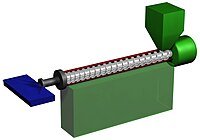
Photo from wikipedia
The rheological properties of drug–polymer mixtures have a significant influence on their processability when using transformative techniques, such as hot-melt-extrusion and material-extrusion 3D printing; however, there has been limited data… Click to show full abstract
The rheological properties of drug–polymer mixtures have a significant influence on their processability when using transformative techniques, such as hot-melt-extrusion and material-extrusion 3D printing; however, there has been limited data on printable systems. This study investigated the rheological properties of 17 formulations of successful printed tablets for both immediate and controlled release. Hydroxypropyl cellulose was used in various ratios to obtain printable filaments in combination with various drugs (indomethacin or theophylline), polymers and disintegrants. The complex viscosity, shear thinning behavior and viscoelastic properties were affected by the drug load, polymer composite, disintegrant type, temperature and shear rate applied. Larger windows of processing viscosity were revealed. The viscosity of the printable blends could be as low as the range 10–1000 Pa·s at 100 rad/s angular frequency. All formulations showed shear thinning behavior with a broad slope of complex viscosity from −0.28 to −0.74. The addition of 30–60% drug or disintegrant tended to have greater viscosity values. While microcrystalline cellulose was found to be an alternative additive to lower the storage and loss modulus among disintegrants. This rheological data could be useful for the preformulation and further development of material-extrusion 3D-printing medicines.
Journal Title: Polymers
Year Published: 2022
Link to full text (if available)
Share on Social Media: Sign Up to like & get
recommendations!